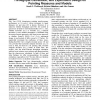Free Online Productivity Tools
i2Speak
i2Symbol
i2OCR
iTex2Img
iWeb2Print
iWeb2Shot
i2Type
iPdf2Split
iPdf2Merge
i2Bopomofo
i2Arabic
i2Style
i2Image
i2PDF
iLatex2Rtf
Sci2ools
CHI
2011
ACM
2011
ACM
The effects of task dimensionality, endpoint deviation, throughput calculation, and experiment design on pointing measures and m
Fitts’ law (1954) characterizes pointing speed-accuracy performance as throughput, whose invariance to target distances (A) and sizes (W) is known. However, it is unknown whether throughput and Fitts’ law models in general are invariant to task dimensionality (1-D vs. 2-D), whether univariate (SDx) or bivariate (SDx,y) endpoint deviation is used, whether throughput is calculated using the mean-of-means approach or the slope-inverse approach, or whether Guiard’s (2009) Form × Scale experiment design is used instead of fully crossed A×W factors. We empirically investigate the confluence of these issues, finding that Fitts’ law is largely invariant across 1-D and 2-D, provided that univariate endpoint deviation (SDx) is used in both, but that for 2-D pointing data, bivariate endpoint deviation (SDx,y) results in better Fitts’ law models. Also, the mean-of-means throughput calculation exhibits lower variance across subjects and dimensionalities than the slope-inverse calculati...
| Added | 25 Aug 2011 |
| Updated | 25 Aug 2011 |
| Type | Journal |
| Year | 2011 |
| Where | CHI |
| Authors | Jacob O. Wobbrock, Kristen Shinohara, Alex Jansen |
Comments (0)

